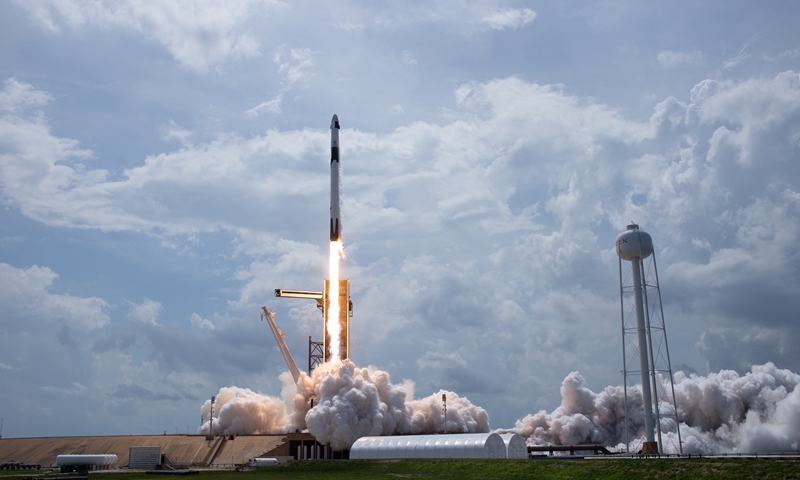SpaceX milestone manned spaceship launch applauded
By Zhang Hongpei Source:Global Times Published: 2020/5/31 21:48:40
Chinese private firm eyes crew flight around 2025

This handout photo released by NASA shows a SpaceX Falcon 9 rocket carrying the company's Crew Dragon spacecraft launched from Launch Complex 39A on NASA's SpaceX Demo-2 mission to the International Space Station with NASA astronauts Robert Behnken and Douglas Hurley onboard at NASA's Kennedy Space Center in Florida on Saturday. Photo: AFP
As Chinese netizens applauded the feat of US commercial space firm SpaceX, which has conducted the first private-sector manned space mission, they also reflected on the state of the commercial space sector in China, where self-reliance is the key.
At 3:22 pm US Eastern Time on Saturday, a SpaceX Falcon 9 rocket lifted off from Florida, bearing a spaceship called Crew Dragon with two men inside - NASA astronauts Bob Behnken and Doug Hurley. It was the first time that US astronauts were sent into space from US soil after a nine-year gap.
The two astronauts were scheduled to join the International Space Station at 10:27 am US Eastern Time on Sunday.
Chinese netizens hailed the launch, saying it has opened a new chapter in manned space missions, and a voyage to Mars might not be far away
"When a parent asks a child about their dreams, it's no longer enough to say 'change the world,' as it should be 'change the universe' now," a netizen said.
Chinese vendors were quick to offer a sequined dinosaur toy on e-commerce platform Taobao.com on Sunday, the same model as the two astronauts took on their flight.
However, it is too soon to call the mission a full victory as the two astronauts also have to come home - a test of the Crew Dragon's ability to return humans safely to Earth. The astronauts will return home sometime in the next six to 16 weeks, the Verge reported.
The Demo-2 launch was originally scheduled for Wednesday afternoon US time, but it was canceled 17 minutes before liftoff because of bad weather.
The successful launch of the mission by SpaceX, founded by Elon Musk 18 years ago, could inspire China's commercial space sector especially in terms of policy, said Huang Zhicheng, a veteran expert in the space industry.
Since 2014, when China started to encourage private companies to enter the space sector, private rocket and satellite firms have mushroomed, while state-owned players have performed a leading role.
"Apart from drawing confidence and inspiration from the SpaceX achievement, it is more important to look at the reform of the space sector - to cut costs and enhance efficiency through competition and flat management structures," Huang told the Global Times on Sunday.
In 2014, NASA awarded contracts to SpaceX and Boeing, but SpaceX took the lead.
Huang said that major space projects need private-sector players, who are better at cost controls and incentivizing talent.
For example, there is China's satellite internet program, which is on the list of China's "new infrastructure" projects. Private space companies could join with state-owned enterprises in the areas of ground terminal equipment and supplementary network launches.
Meanwhile, China and the US have had nearly zero communications in the sensitive space industry as bilateral ties have soured in recent years.
"China has emerged as a world space power based on its own technologies, which proves that the US' technology controls to contain China won't squeeze us to death. On the contrary, our space industry has survived and thrived, although the process might take a few more years," Huang said.
Yao Bowen, a vice president of private rocket firm iSpace, dubbed as China's answer to SpaceX, told the Global Times on Sunday that "SpaceX is further along the track, but we share its vision of eventually sending passengers into space via cost-effective modules."
iSpace will accelerate its pace in research and development, Yao said. He said the company would probably be able to achieve manned space trips by about 2025.
Its self-developed reusable liquid oxygen-methane engine JD-1, the first of its kind and a key breakthrough in vertical landing rocket technology, completed a key secondary start test last week. The company plans a launch mission in the first half of 2021, according to Yao.
The carrier rocket built by iSpace sent satellites into orbit from the Jiuquan Satellite Launch Center in Northwest China's Gansu Province in July 2019, a milestone for China's commercial space industry. iSpace was the first private-sector space firm to do so, after two earlier failures by leading rocket start-ups OneSpace and LandSpace.
RELATED ARTICLES:
Posted in: SOCIETY